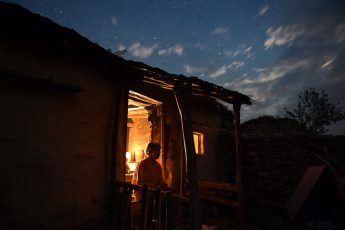(Soul-)Searching for the Real
Ivana Mladenović’s Ivana the Terrible (Ivana cea Groaznică, 2019)
Vol. 116 (Summer 2021) by Ana Ribeiro
Released in 2019, Ivana, The Terrible is Ivana Mladenović’s second fiction feature film. “Fiction”, in Mladenović’s cinema, is a fluid concept, since visual codes and narrative methods mostly associated with documentary cinema permeate her “fiction” films.
Born in Kladovo, Serbia, in 1984, Ivana went to film school in neighboring Romania. It is in her adopted country that she has built a career in film, first as a documentary filmmaker, and later transitioning to “fiction” (an explanation for my use of quotation marks will follow in a second). In 2017, she releases Soldiers, Story of Ferentari based on the homonymous autobiographical novel. The book’s author, Adrian Schiop, plays the protagonist in the film (who is based on Schiop’s own persona) and shares the scriptwriting credits with Mladenović. Based on an “autofiction” novel, this film showcases realism-inducing resources that will be taken even further in Ivana, The Terrible.
In this article, we’ll be using the term “autofiction” as defining autobiographical-fictional works. “Autofictional” works subvert the limits of fiction and non-fiction, using both elements from the author’s life and made-up events when creating the narrative. If in her first “fiction” Mladenović builds the story upon someone else’s autobiographical fiction, in Ivana, The Terrible she recreates her own story.
The starting point of this project were the anxiety attacks Mladenović had been experiencing while living in Bucharest. When trying to figure out the origins of her physical symptoms and a way out of her distress, the author decided to reenact some episodes of her life by going back to her hometown and inviting ex-lovers, friends, and family to take part. This therapeutic, real-life act is then transformed into fiction, serving as the basis for the film’s narrative. Therefore, the main characters in the film are played by Ivana’s real entourage, be them her relatives or pals. Ivana, the auteur, also plays Ivana, the protagonist.
As a matter of fact, the autobiographical aspect is evident even in the film’s original and international title. More than being a reference to the filmmaker’s name and to Russia’s 16th century Tsar, the nickname “the Terrible” defines someone who not only inspires fear, but who’s also powerful, intense or just a brat – all characteristics of “autofictional” Ivana.
In the film’s fictional space, troubled Ivana is an alien element in the familiar, small-town environment she returns to. This same ambiance in turn destabilizes Ivana’s own self. The first sequence of the film interestingly conveys the dubious nature of the disturbance Ivana both represents and undergoes. Set on the train she’s taking from Bucharest to her Serbian village, it shows Ivana trying to keep a conversation going that she is having with a mother and her children. She’s chatty as she tells them about her lifestyle. The mother seems to listen to Ivana, who in turn seems to subtly empathize with the little girl in front of her. Meanwhile, her ideas seem to derange some older ladies seating nearby who are vocal about their disapproval. This dynamic that includes figures of the mother/motherhood, the child, and the elderly, echoes the conflicts permeating the story. Filmed with a shaky handheld camera, quickly shifting points-of-view, here we have Ivana filmed as the main character of a direct cinema documentary. The audience is made to believe that they’re in fact watching a real-life, coincidental interaction. However, this sequence is already a reenactment.
Similar visual language is used throughout the film. The minimalist grammar of the Romanian New Wave is cleverly employed to convey realism. However, more formal choices such as careful, stable framing, clearly scripted dialogues and coordinated mise-en-scène make it clear that we’re in fact watching a fiction film. Therefore, the use of minimalist Romanian New Wave grammar is very coherent in a film that reenacts real-life events, but clearly states the fictional aspect of the author’s point of view. Let’s not forget that reenactment is also a dramatic procedure with historical roots in Romania’s auteur cinema, being central, for example, in the seminal film by Lucian Pintilie, The Reenactment, from 1968. Interestingly enough, the theme of reinterpretation, this time of historical events, will appear in the end of Mladenović’s film.
Ivana’s life reenactment is full of self-criticism, which is visible in her interactions with her surroundings. The conflicts are intergenerational – at first, Ivana seems to behave like a self-absorbed brat. Her relationship with her parents isn’t the most stranded though. They seem willing to accept her behavior, while trying to reason with their daughter that she should look for treatment. Meanwhile, Ivana is harsh to her grandmother, not showing much compassion or tolerance towards the elderly lady, who is clearly starting to show signs of dementia. The grandmother has no filter, judging Ivana according to her old-school thoughts. The granddaughter takes every one of her remarks seriously, although the other relatives don’t seem to do that to the same extent. Actually, besides the aging granny, it’s people from outside the family that will judge Ivana’s behavior and lifestyle more harshly. As she returns to the environment of her childhood and youth, it is Ivana, through her brat-like behavior, who positions herself as a child, and not her family that imposes this role on her – contrary to what one may expect.
Family dynamics in which parents or relatives infantilize their teenage or even adult children is a theme that has been treated in other contemporary Romanian films, such as Calin Peter Netzer’s Child’s Pose (2013), Radu Jude’s The Happiest Girl in the World (2009) or Razvan Radulescu’s and Melissa de Raaf’s First of all, Felicia (2009). However, the very nature of self-reenactment in Ivana, The Terrible provokes a shift in the interactions among characters. In the films cited above, parents are the driving agents behind trying to preserve positions of social and intellectual authority and are hence willing to pervasively protect their grown-up children. However useful as these behaviors may be for the offspring, they ultimately reject them. Even when the interactions between parent and child are more ambiguous, as in Netzer’s film, the children still somehow resist being positioned as immature, helpless kids. Through her search for self-understanding (both as author and character), on the other hand, Ivana seems willing to make herself vulnerable. Therefore, there is a clear sense of agency behind Ivana’s finding herself back in her nest.
The other main point of conflict is cultural. Ivana’s transnational identity is put to the test in her journey of self-analysis. Though she works as an actress in Bucharest – she even starred in one film! – , Ivana is far from being a star. Back in her small hometown, however, she’s quickly embraced by local politicians as the most accomplished “child of the land”, therefore earning some respect. Towards the end of the film, she is awarded with a symbolic prize for her contributions towards Serbian-Romanian friendship. On the other hand, when confronted with day-to-day exchanges, she will notice that her more cosmopolitan lifestyle doesn’t fit with her native context. She’s in her mid-thirties and is constantly reminded, both by the family and a doctor, that she will inevitably be a mother (which does not seem to be a personal priority); she also has to hide her relationship with a man 12 years her junior (as this age-gap is still taboo when the woman is senior). In one of the most comic sequences, Ivana’s artist friend from Bucharest brings up a superficial yet provocative view of feminism at an official lunch, and thereby provides a cause for embarrassment. Ivana then navigates a difficult position between two conflicting worlds, trying to make sense of her own identity while soul-searching for inner peace. The framing, especially in interior scenes, shows the characters close to several sharp angles made by decorative elements. Doors, windows, and pieces of furniture are square, pointy, and limiting, all with clear outlines. It is Ivana, the transnational, who then introduces some smoothness to these sharp social contours, be it intentionally or not. She does not oppose the rules imposed on her all too vocally. If she shows her dissatisfaction with the imposed idea of motherhood, it is within her family environment; hiding her relationship, although bothersome, is not that big of a deal. She is however dissatisfied by her friend’s provocative sexiness, and not only out of jealousy.
Ivana’s motivations and reactions are very personal, and yet they have repercussions that can be felt within her and in her immediate environment. She uses her official privileged status as a symbol of her town to invite an ex-boyfriend and his current girlfriend (the sexy, feminist friend) and their experimental music project to play in the town’s festival. Although the show is a big failure, it does not change Ivana’s status as Kladovo’s biggest exploit. The clear, conservative boundaries and social codes of the town won’t change significantly: the effects of her actions are either directed towards herself or are felt subtly by other people around her.
Yet, Ivana is also a symbol of a significant historical shift. By the end of the film, we see the official commemorations of the friendship between Romania and Serbia. Kladovo is conveniently situated at the border and is home to a big achievement of Communist engineering, the Iron Gate power plants, a joint venture between Romania and Yugoslavia. The celebrations – which include speeches and poetry readings – are reminiscent of the two regions’ common past. However, as discussed during this sequence, something has changed: while Serbia, as part of Yugoslavia, had helped out poorer Romania during Communist times, it is now Romania, as part of the EU, that is the more prosperous country between the two neighbors. Ivana’s achievement then also resides in the fact that she “made it” in this somewhat more fortunate land. She does not seem bothered, though, and remains cheerful throughout the comical event.
By reenacting her real-life episodes, Mladenović delves into her own transnational identity. By looking closely into her inner world with a realist, documentary-like approach, she makes a funny, tender and deeply personal comment echoing broader historical issues. Ivana Mladenović’s use of autofiction and reenactment make her one of the most interesting filmmakers in Romanian (and Serbian, etc.) cinema. Surely, she is someone to follow closely.




Leave a Comment